Photo: Berkeley Lab researchers, including Michelle Newcomer (right), are collaborating with USGS and the Sonoma County Water Agency to study how the water resources respond to extreme events such as fire. (Photos courtesy Michelle Newcomer)
Scientists at the Department of Energy’s Lawrence Berkeley National Laboratory (Berkeley Lab) spent a decade developing world-class modeling and monitoring capabilities to pinpoint factors behind the success of Sonoma’s riverbank filtration system. They were turning their attention to investigating the potential impact of extreme events, such as storms and wildfires, when disaster struck.
Suddenly, their experimental approaches to predicting how the system would respond to hypothetical situations are being used to explore real-life perturbations. Catastrophic fires in Northern California burned more than 110,000 acres in Sonoma and Napa counties last month – including 8 percent of the Russian River watershed. Now with the rainy season underway Berkeley Lab’s research – which seeks to understand how the hydrology and microbiology of the surface and groundwater system respond to extreme events – has become even more critical.

“We were studying the potential impact of fires on the nutrient, solute, and metal delivery to the river,” said Berkeley Lab researcher Michelle Newcomer . “With this unfortunate turn of […]
Full article: Research Becomes Reality in Study of Fire Impact on Sonoma Water Resources



